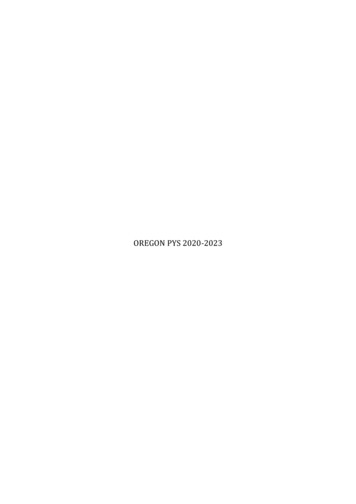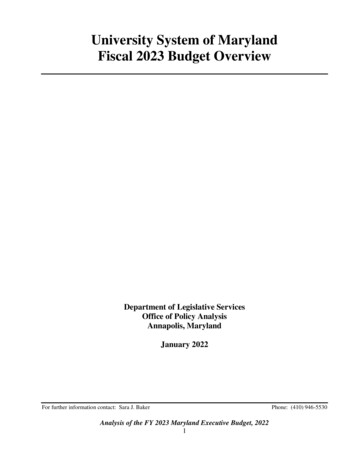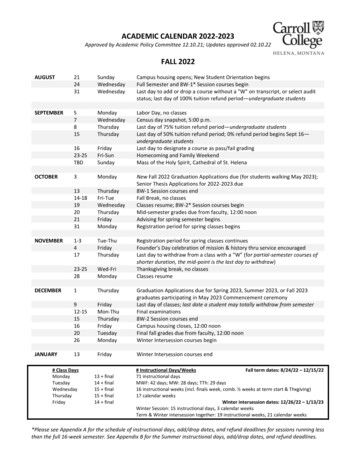
Transcription
OREGON PYS 2020-2023
CONTENTSOregon PYs 2020-2023 . 1I. WIOA State Plan Type and Executive Summary . 3a. WIOA State Plan Type. 3Combined Plan Partner Program(s) . 3b. Plan Introduction or Executive Summary . 3II. Strategic Elements . 3a. Economic, Workforce, and Workforce Development Activities Analysis . 3b. State Strategic Vision and Goals . 37c. State Strategy . 40III. Operational Planning Elements . 44a. State Strategy Implementation . 44b. State Operating Systems and Policies . 66IV. Coordination with State Plan Programs . 110V. Common Assurances (For All Core Programs) . 110VI. Program-Specific Requirements for Core Programs . 111Program-specific Requirements for Adult, Dislocated Worker, and Youth Activities underTitle I-B . 111Program-Specific Requirements for Wagner-Peyser Program (Employment Services) . 138Program-specific Requirements for Adult Education and Family Literacy Act Programs . 169Program-Specific Requirements for Vocational Rehabilitation (Combined or General) . 181Program-Specific Requirements for Vocational Rehabilitation (Blind). 251VII. Program-Specific Requirements for Combined State Plan Partner Programs . 322Employment and Training Programs Under the Supplemental Nutrition Assistance Program(Programs Authorized Under Section 6(d)(4) of the Food and Nutrition Act of 2008 (7 U.S.C.2015(d)(4))) . 322Trade Adjustment Assistance (TAA) . 483Senior Community Service Employment Program (SCSEP). 483Housing and Urban Development (HUD) Employment and Training Activities . 497Performance Indicator Appendix . 497All WIOA Core Programs . 497Additional Indicators of Performance . 498Other Appendices. 498Page 2
I. WIOA STATE PLAN TYPE AND EXECUTIVE SUMMARYA. WIOA STATE PLAN TYPEThis is a combined planCOMBINED PLAN PARTNER PROGRAM(S)Employment and Training programs under the Supplemental Nutrition Assistance Program(programs authorized under section 6(d)(4) of the Food and Nutrition Act of 2008 (7 U.S.C.2015(d)(4)))Trade Adjustment Assistance for Workers programs (activities authorized under chapter 2 oftitle II of the Trade Act of 1974 (19 U.S.C. 2271 et seq.))Senior Community Service Employment program (programs authorized under title V of theOlder Americans Act of 1965 (42 U.S.C. 3056 et seq.))Employment and training activities carried out by the Department of Housing and UrbanDevelopmentB. PLAN INTRODUCTION OR EXECUTIVE SUMMARYCOVID-19 AcknowledgementOregon’s 2020-2023 WIOA State Combined Plan was prepared prior to the COVID-19 globalpandemic. There has not been an opportunity to adjust any of the Plan elements to reflectresponses to the COVID-19 emergency. Oregon expects to make modifications to the 2020-2023WIOA State Combined Plan at an appropriate time. Since all states will likely be in a similarsituation, Oregon requests Guidance regarding the content and process of COVID-19-relatedmodifications.Introduction to Oregon’s 2020-2023 WIOA State Combined PlanOregon's Combined State Plan reflects the work of multiple agencies and organizations. Each ofthese entities have their own missions, visions, and values and this Plan weaves these togetheron behalf of the broader workforce development system to realize equitable prosperity for allOregonians. Delivering on this requires keen attention to the employment and skill needs ofbusiness and industry both now and into the future and requires access to timely education andtraining for all individuals that is both valued in the marketplace and also results in or creates apathway to self-sufficiency. This Plan demonstrates Oregon's commitment to continuousimprovement in the workforce development system to ensure increasing alignment of prioritiesand strategies to maximize resources currently within the workforce development system andto leverage additional resources not yet a part of the system.II. STRATEGIC ELEMENTSA. ECONOMIC, WORKFORCE, AND WORKFORCE DEVELOPMENT ACTIVITIES ANALYSIS1. ECONOMIC AND WORKFORCE ANALYSISIntroduction to Oregon’s Economic and Workforce AnalysisOregon’s economy is strong as it wraps up its ninth year of job growth and third year of recordlow unemployment. Job growth is strong, with 27,800 jobs added in the past 12 months. OregonPage 3
is adding jobs at about the same pace as the nation. This long-run of job growth has helped tolower the unemployment rate to record lows for the state.The unemployment rate dropped to record lows three years ago, with Oregon’s rate dipping to4.6 percent in October 2016. It has remained in record low territory ever since, rangingbetween 4.1 percent and 4.4 percent. Most recently, Oregon’s unemployment rate was 4.1percent in October 2019. Oregon’s historical average unemployment rate is 7.0 percent, so thecurrent level of low unemployment presents much tighter labor force conditions than typical forthe state.Oregon’s economy faces many of the same demographic challenges seen across the nation, suchas the aging of the workforce and baby boomer retirements, fewer young people participating inthe labor force, and slower job growth in rural areas. Oregon’s labor force growth has beenrelatively slow during the past three years, stabilizing around 2.1 million people. Populationgrowth has driven labor force growth in recent years. This is a result of natural increase (birthsminus deaths) and net migration. As labor force participation trends down due to increasedretirements and lower participation among youth, future labor force growth could be limited tothe rate of population growth.Current forecasts indicate Oregon’s economy will continue to see similar job growth over thenext few years, before slowing significantly in 2023 and beyond. The December 2019 OregonOffice of Economic Analysis’ Economic and Revenue Forecast projects the state will gain121,300 jobs by 2025. The unemployment rate is expected to stay close to where it is, with theannual average for 2020 forecasted to be 3.8 percent. The rate is expected to rise to 4.0 percentin 2022, before stabilizing around 4.3 percent through 2025.Oregon’s Economic AnalysisGraph 1 shows the number of jobs by industry added during the previous year and the averageannual pay in those industries in 2018. The gains have been in industry sectors with high-,middle-, and low average pay. Health care and social assistance added 7,100 jobs, the most forany sector. Other sectors driving Oregon’s job growth are transportation, warehousing, andutilities (3,900), state and local government (3,700), leisure and hospitality (3,600), andprofessional and business services (3,400 jobs). Retail trade was the only large sector withsignificant losses during the past year and is down 2,400 jobs. Retail trade job losses areoccurring nationally, not just in Oregon.Graph 1. Oregon Job Growth and Average Pay by Industry Comparing October 2018 to October2019 and Displaying 2018 Average Pay.Page 4
Source: Oregon Employment DepartmentGraph 2 shows the projected net job change from the fourth quarter of 2019 to the fourthquarter of 2020. Net job gains are expected across all the major private industries. Professionaland business services is expected to continue adding a lot of jobs ( 11,600), followed by healthcare and social assistance (6,800), leisure and hospitality (5,000), and local government (2,900),which includes public K-12 schools and public higher education.Graph 2. Expected Job Changes by Industry Sector Over the Year Comparing the Fourth Quarterof 2019 to the Fourth Quarter of 2020.Source: OED analysis using OEA Forecast, December 2019Oregon's Workforce AnalysisPage 5
The Portland-Vancouver-Hillsboro area is Oregon’s largest metropolitan area and is split alongthe Oregon and Washington state border. Most of the metro area’s residents and jobs are on theOregon side. The Portland metro area has a labor force of more than 1.3 million people. BecausePortland’s economic region crosses the state border, many workers in Oregon actually live inWashington. In 2017 there were about 85,000 people working in Oregon who lived inWashington. The area’s 3.9 percent unemployment rate was about the same as Oregon’sstatewide unemployment rate in October 2019.Unemployment rates tend to be about the same or slightly higher in Oregon’s other metro areas.The unemployment rate in the Bend-Redmond metro area is 4.1 percent, Eugene is 4.4 percent,Salem is 4.4 percent, Medford 4.6 percent, Albany is 4.7 percent, and Grants Pass is 5.4 percent.Although the unemployment rate is higher in Grants Pass, it too is at record low levels for thearea. The exception is the Corvallis metro area, which is economically buoyed by Oregon StateUniversity. At 3.3 percent, Corvallis has the lowest unemployment rate in the state.Unemployment is higher in the eastern and southern regions of the state. Grant County ineastern Oregon has the highest rate at 7.0 percent. Other counties with especially highunemployment are Klamath County (6.7%), Wallowa County (6.5%), and Lake County (5.8%).Overall, non-metro area unemployment was 5.1 percent in October 2019.Figure 1. Map of Oregon Counties showing the Seasonally Adjusted Unemployment Rate forOctober 2019.Source: Oregon Employment Department, Local Area Unemployment StatisticsAs workers progress in their careers, they may change occupations. This creates an opening inthe occupation they leave that can be filled by someone new to the occupation who may needtraining to fill that opening. Also, when a worker reaches the end of their career, they leave thelabor force, again creating an opening that may require a trained worker to fill it.We use the phrase “replacement openings” for the total number of occupational openings due topeople changing occupations or leaving the labor force. Far more workers are needed to fillreplacement openings than for “growth openings” that are due to net job growth. Even in somePage 6
occupational groups with little anticipated net job growth, replacement openings can benumerous.Projections by the Oregon Employment Department indicate that Oregon will have about25,000 job openings each year due to economic growth between 2017 and 2027. However,there are going to be an additional 238,000 replacement job openings annually from workerspermanently leaving their occupations, mostly due to retirements.Projected growth and replacement job openings by industry are shown in Graph 3. Health careand social assistance will have the most openings through 2027, but of the 33,000 expectedopenings each year, 86 percent will be due to replacement needs. In fact, most job openingsacross industries will be from replacements as more workers enter retirement. As the laborforce continues to age, replacement openings are likely to become more numerous and theassociated need for training is likely to grow.Graph 3. Projections for 2017-2027 of Average Annual Job Openings by Industry in Oregon.Source: Oregon Employment DepartmentKey Labor Market Trend - Shifting Hiring Conditions Among Oregon Employers:Throughout the year, the Oregon Employment Department surveys private employers from allindustries and areas of the state to ask about the job vacancies they are actively trying to fill.Employers provide the job title, starting wage, and education and experience requirements foreach of their vacancies. They also specify whether their vacancies are for full or part-timepositions, and permanent or seasonal jobs. If they face hiring challenges, employers also write inthe primary reason for difficulty filling each job opening.The Oregon Job Vacancy Survey has included an open-ended question about employers’difficulty filling job openings since 2013. In that year, businesses cited a lack of qualifiedcandidates as the most common hiring challenge. This difficulty finding workers with a specificPage 7
mix of education and experience accounted for 3,600 (24%) of all hard-to-fill vacancies withreasons provided.As hiring demand strengthened, employers’ hiring challenges shifted. Each year from 2014through 2018, a lack of applicants was the most common reason businesses gave for difficultyfilling vacancies. The share of difficult-to-fill vacancies with either too few or no applicantspeaked during 2015 and 2016, the period of the strongest annual job growth in Oregon duringthis expansion (3.4% and 3.0%, respectively). In 2016 alone, a lack of applicants accounted for12,100 (38%) of all difficult-to-fill job openings.Graph 4. Profile of the Reasons for Difficult-to-Fill Job Vacancies in Oregon for 2013 through theThird Quarter of 2019.Source: Oregon Employment Department, Oregon Job Vacancy SurveyAs Oregon reached its record low unemployment rate (4.0%) in November 2016, and hasmaintained that low unemployment for three years, a new hiring challenge has emerged.“Unfavorable working conditions” includes part-time, on-call, overnight, or inconsistent workschedules, as well as difficult physical working conditions. Employers reported unfavorableworking conditions as the primary hiring challenge for 3,100 (or 11%) of the difficult-to-fillvacancies in 2015 and 3,600 in 2016 (11%). That grew to 5,000 (14%) in 2017, and rose againto 6,500 (24%) in 2018. During the first three quarters of 2019, the share has remained stableat 24 percent.At the same time, the lack of applicants has declined, and other reasons have become slightlymore prominent as businesses’ primary hiring challenges. Among those has been an increase indifficulty filling jobs because of the work location. This challenge tends to occur in rural areas ofthe state. More businesses have also reported difficulty filling job openings due to a lack ofaffordable housing in the area – particularly along the North Coast, in Central Oregon, and in theColumbia Gorge.Oregon’s private employers have reported nearly 53,000 job vacancies at any given timethrough the first three quarters of 2019. While that’s a decline of about 9 percent from nearlyPage 8
58,000 job vacancies in 2018, hiring demand is still relatively strong. To date in 2019, thenumber of job openings looks similar to the levels seen during the strongest job growth in thisexpansion during 2015 (48,000 vacancies) and 2016 (51,000).With three years of unemployment rates at or near record lows and continued demand forlabor, employers offering jobs with difficult physical or scheduling conditions are increasinglyreporting these challenges as the primary difficulty filling vacancies. Offering higher wages,employee perks, or benefits may be strategies to broaden interest in vacancies. Jobs withunfavorable working conditions also tend to require relatively less training or experience. Thiscould open opportunities for workforce development organizations to help connect job seekersamenable to tough physical jobs or alternative work schedules with businesses struggling to fillthose types of jobs.Key Labor Market Trend - Automated/Autonomous Vehicles:Oregon’s eight primary driving occupations and 14 secondary autonomous vehicle-affectedoccupations will account for 5 percent of total employment with 104,000 jobs in 2027. Over thefollowing 10 to 15 years, various household autonomous vehicle (AV) adoption scenarios –either personal ownership or shared/fleet use – could affect between 11,700 and 14,700 jobs.That totals between 11 percent and 14 percent of all jobs in those occupations.Commercial trucking scenarios for AV adoption could affect between 29,800 and 32,600 jobs inthese occupations looking into the 2040s, depending upon the pace of implementation. Thoseimpacts would be felt for between 29 percent and 31 percent of all jobs in primary driving andsecondary affected occupations.Table 1. Estimates of Oregon Jobs affected by 2040 under Various Household and CommercialAdoption Scenarios.Combined Household and Commercial Adoption ScenarioJobs Affected*Personal Cars Slow Trucking41,500Fleet Cars Slow Trucking44,400Personal Cars Fast Trucking44,300Fleet Cars Fast Trucking47,200* Affected does not always equal "lost". Some affected occupations may still exist, with notably different skills and responsibilities on the job.Source: Oregon Employment Department calculations using framework from Preparing U.S. Workers and Employers for an Autonomous VehicleFuture, Groshen et al., June 2018.Taken together, the various combinations of personal and commercial AV adoption scenarioscould affect between 41,500 and 47,200 jobs in Oregon, starting around the year 2030. Thelargest impacts would occur for heavy and tractor-trailer truck drivers under the commercialscenarios, where 16,200 to 17,500 jobs could be affected. Under the household AV adoptionscenarios, estimated job effects are largest for automotive service technicians and mechanics(4,000) and service station attendants (2,600 to 3,900).Workers in primary driving jobs affected by AV adoption are slightly more likely to be workersnearing retirement. While one out of every four jobs in Oregon is held by a worker age 55 orolder, about one-third of workers in primary driving jobs are at least 55 years old.Page 9
Key Labor Market Trend - Forest Industry Sector:Forest sector-related employment in Oregon totaled 61,100 in 2017, which accounted for 3percent of Oregon’s workforce. Forest-related jobs paid relatively well, with an annual averagewage of 54,200, roughly 6 percent more than 51,100 for all jobs covered by unemploymentinsurance in 2017.Although metros accounted for twice as many of these jobs, forest sector employment made up7 percent of all rural employment, compared with 2 percent of all metropolitan areaemployment. In Grant County, one out of every five jobs (21%) was forest-related. The sectoraccounted for more than 10 percent of the total in Douglas, Jefferson, and Lake counties.The forest sector also held relative importance to rural Oregon in terms of wages. Inmetropolitan areas, forest sector wages sometimes paid less than the annual average for alljobs, but could also pay as much as 35 percent more. Meanwhile, forest sector jobs in rural areaspaid as much as 92 percent more than all jobs. That was the case in Clatsop County, whereforest sector jobs paid an average of 70,600, compared with 36,800 for all jobs. LincolnCounty was similar, with an average annual forest sector wage ( 68,400) that was 86 percentabove the all-job average ( 31,200).Figure 2. Map of Oregon Counties showing the Forest Sector Wages relative to All Covered Jobsin 2017. All Covered Jobs in Oregon is 3,100 (or 6%) Higher.Sources: Oregon Employment Department, Quarterly Census of Employment and Wages; U.S. Census Bureau Non-employer StatisticsKey Labor Market Trend - Maritime Industry Sector:Oregon’s maritime sector workforce totaled nearly 19,000 in 2017. Oregon’s covered maritimeindustries paid a total of nearly 608 million in wages in 2017. The average annual wage ofcovered jobs in Oregon’s maritime industry was 60,853. That is 19 percent higher thanOregon’s overall annual wage of 51,117. Average annual wages vary depending on industry,Page 10
ranging from a low of 27,850 in fish and seafood markets to a high of 139,144 in sea andcoastal transportation.Table 2. Oregon's Maritime Workforce in 2017.Maritime WorkforceNumber of JobsCovered Maritime Sector Jobs10,019Commercial Fishing in Oregon3,498Commercial Fishing in Distant Waters1,447Mariners with a U.S. Coast Guard Credential2,598U.S. Coast Guard and Navy Service Members1,653Total Maritime Workforce*18,981* Covered commercial fishing jobs excluded from the total to avoid double-counting.Source: Oregon Employment Department from various sources.Maritime sector jobs are prevalent on the Oregon Coast, of course, but maritime sector jobs canbe found in 33 of Oregon’s 36 counties. The only counties without a measurable maritimeworkforce were Harney, Malheur, and Wheeler counties.Figure 3. Map of Oregon Counties showing the Maritime Sector Covered Jobs and Maritime Nonemployers. The Total for Oregon is 12,036 (0.06% Share of All Jobs).Source: Oregon Employment Department (2017) and U.S. Census Bureau, Nonemployer Statistics (2016)In some communities, maritime sector jobs are a large portion of the total workforce. Thecounties with the largest portion of workforce in the maritime sector are Sherman (12.9%),Lincoln (6.5%), Clatsop (5.2%), Coos (4.1%), Curry (3.6%), and Tillamook (2.3%).Page 11
The maritime sector workforce tends to be older than Oregon’s overall workforce. About 27percent of jobs in Oregon’s covered fishing, maritime manufacturing, and transportation jobsare held by workers age 55 years and over. That’s a higher share than the 23 percent of theoverall workforce.Key Labor Market Trend - Defining a True Wage:The Oregon Workforce and Talent Development Board (WTDB) aims to support Oregonworkers as they pursue careers that allow them to prosper and provide for themselves. To thisend, the board sought additional information about the current definition of “high-wage jobs” inOregon and whether it meets the threshold of self-sufficiency, especially for all regions of thestate and for all family types. To review the relevant issues and develop possiblerecommendations, the board formed a task force to review how the current definition of highwage occupations was used by workforce partners and state agencies, and compared thatdefinition with definitions used in other states.Oregon is currently using an “above median wage” definition of high wage jobs, comparing anoccupation’s median wage with the median across the state or local workforce area. Oregon’sdefinition is similar to other states that currently have definitions for high-wage jobs; in mostcases either a median or a mean wage is used to define occupations or industries with highwages.The True Wage Task Force defines a “true wage” as a wage that meets or surpasses thethreshold of self-sufficiency in all regions of the state and for all family types. Defining a truewage is a complicated endeavor. It includes analysis of the compensation and benefits for manydifferent occupations compared with a broad analysis of cost-of-living components in all regionsof the state and for all family types.A review of existing regional and national initiatives to measure self-sufficiency showed thatmany of these measures focus on identifying a spectrum of thresholds which describe whatincome level it takes for a household to be self-sufficient. Our staff also provided informationabout the benefits offered by employers based on original survey research, collected data aboutthe state’s housing market, and provided U.S. Department of Education student debt data forOregon post-secondary institutions.The resulting report Understanding the True Costs of Self-Sufficiency helped define the problem,provided some related data and analysis, and helped the task force lay the groundwork todevelop recommendations so that the board can coalesce around a “true wage” definition. Twokey policy areas arose out of this report related to housing and childcare which areacknowledged as key workforce issues. This foundational work will underpin future researchand support the development of tools and resources that would assist business and policystakeholders as they track self-sufficiency in Oregon.Workers with Barriers - Older Workers:Baby boomers have dramatically changed the age structure of Oregon’s workforce. In 1998, theoldest baby boomers were just 52 years old and the overall workforce was much younger. Twodecades ago, just over 10 percent of Oregon’s workforce was age 55 years or older. In 2018, 23percent of Oregon’s workforce was 55 years and over (Graph 5).Page 12
Graph 5. The Share of Oregon Workers Who are 55 or Older between 1992 and 2018. NearlyOne out of Four Workers in Oregon is 55 or Older.Source: U.S. Census Bureau, Local Employment DynamicsThe number of workers in Oregon who were 55 years and over reached nearly 439,000 in 2018.Of those workers 124,000 were age 65 years and older and working past the traditional age ofretirement.Older workers can be found in jobs in all industries, of course, but some industries have a largeconcentration of older workers. In Oregon, the industry sectors with a larger than average shareof workers 55 years and older are mining (32%), utilities (31%), agriculture and forestry(31%), real estate (29%), transportation and warehousing (29%), public administration (28%),other services (28%), educational services (28%), wholesale trade (26%), manufacturing(25%), health care (24%), and finance and insurance (24%). These industries may face atougher time finding enough replacement workers as these older workers head towardretirement. At the same time, older workers looking to remain in the workforce may find jobopportunities in these sectors if they have relevant experience.Rural areas in Oregon also have a large concentration of older workers. In fact, the only countieswith a smaller share of older workers than the statewide average are Washington County(21%), Multnomah County (21%), and Deschutes County (22%).Workers with Barriers - Long-Term Unemployed:Nearly a decade ago, in the early stages of the economic recovery from the Great Recession, thenumber of long-term unemployed Oregonians spiked to nearly 102,000, the highest number ofrecord. Long-term unemployed are those who have been unemployed for at least six months.The longer an unemployed worker remains unemployed, the less likely they are to find a steadyfull-time job, and the more likely they are to leave the labor force. Researchers have found thatlong-term unemployment can lead to a decline in the workers’ knowledge, skills, and abilities,making it harder for them to qualify for available jobs. Other studies show that employersPage 13
discriminate against the long-term unemployed, making it less likely for an unemployed workerto receive an interview. These barriers to employment exist even in a strong economy.The total number of unemployed Oregonians has been very low recently, hovering around90,000 for the last three years. Long-term unemployment has also returned to levels last seenprior to the Great Recession. Over the past year, the number unemployed for longer than sixmonths averaged 16,300 – less than one-fifth of the long-term unemployment peak reached in2010. Still, even amidst the lowest unemployment rates on record in Oregon, one out of sixunemployed Oregonians has been unemployed for six months or longer.Although the number of long-term unemployed Oregonians has fallen below pre-recessionlevels, it took about seven years of economic recovery to reduce long-term unemployment to itspresent level. In addition to how persistent long-term unemployment was post-recession, it’sunclear from the data whether most of the improvement came from long-term unemployedfinding work, or if many left the labor force altogether.Workers with Barriers - Race and Ethnicity:The population of Oregon has grown to almost 4.2 million. Our median age is slightly higherthan the national average, at 39.6 years, compared with 38.2 years across the U.S. More thannine out of 10 Oregonians ages 25 and over have completed high school or more education, asl
area. The exception is the Corvallis metro area, which is economically buoyed by Oregon State University. At 3.3 percent, Corvallis has the lowest unemployment rate in the state. Unemployment is higher in the eastern and southern regions of the state. Grant County in eastern Oregon has the highest rate at 7.0 percent.










